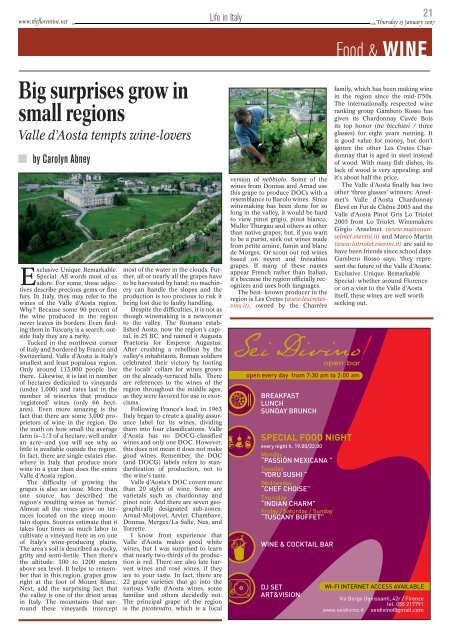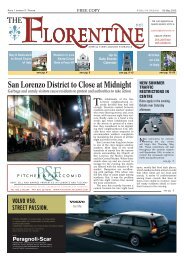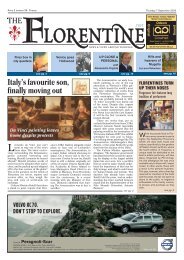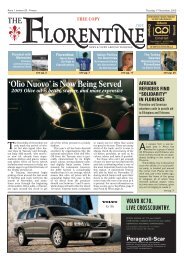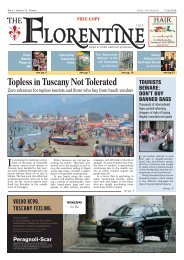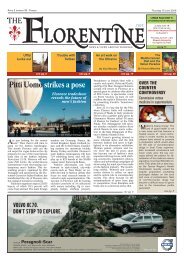Florentine beauties get face-lift - The Florentine
Florentine beauties get face-lift - The Florentine
Florentine beauties get face-lift - The Florentine
Create successful ePaper yourself
Turn your PDF publications into a flip-book with our unique Google optimized e-Paper software.
www.theflorentine.netLife in Italy21Thursday 25 January 2007Food & WINEBig surprises grow insmall regionsValle d’Aosta tempts wine-loversby Carolyn AbneyExclusive. Unique. Remarkable.Special: All words most of usadore. For some, these adjectivesdescribe precious gems or finefurs. In Italy, they may refer to thewines of the Valle d’Aosta region.Why? Because some 90 percent ofthe wine produced in the regionnever leaves its borders. Even findingthem in Tuscany is a search; outsideItaly they are a rarity.Tucked in the northwest cornerof Italy and bordered by France andSwitzerland, Valle d’Aosta is Italy’ssmallest and least populous region.Only around 113,000 people livethere. Likewise, it is last in numberof hectares dedicated to vineyards(under 1,000) and rates last in thenumber of wineries that produce‘registered’ wines (only 66 hectares).Even more amazing is thefact that there are some 3,000 proprietorsof wine in the region. Dothe math on how small the averagefarm is—1/3 of a hectare; well underan acre—and you will see why solittle is available outside the region.In fact, there are single estates elsewherein Italy that produce morewine in a year than does the entireValle d’Aosta region.<strong>The</strong> difficulty of growing thegrapes is also an issue. More thanone source has described theregion’s resulting wines as ‘heroic’.Almost all the vines grow on terraceslocated on the steep mountainslopes. Sources estimate that ittakes four times as much labor tocultivate a vineyard here as on oneof Italy’s wine-producing plains.<strong>The</strong> area’s soil is described as rocky,gritty and semi-fertile. <strong>The</strong>n there’sthe altitude: 300 to 1200 metersabove sea level. It helps to rememberthat in this region, grapes growright at the foot of Mount Blanc.Next, add the surprising fact thatthe valley is one of the driest areasin Italy. <strong>The</strong> mountains that surroundthese vineyards interceptmost of the water in the clouds. Further,all or nearly all the grapes haveto be harvested by hand; no machinerycan handle the slopes and theproduction is too precious to risk itbeing lost due to faulty handling.Despite the difficulties, it is not asthough winemaking is a newcomerto the valley. <strong>The</strong> Romans establishedAosta, now the region’s capital,in 25 BC, and named it AugustaPraetoria for Emperor Augustus.After crushing a rebellion by thevalley’s inhabitants, Roman soldierscelebrated their victory by lootingthe locals’ cellars for wines grownon the already-terraced hills. <strong>The</strong>reare references to the wines of theregion throughout the middle ages,as they were favored for use in exorcisms.Following France’s lead, in 1963Italy began to create a quality assurancelabel for its wines, dividingthem into four classifications. Valled’Aosta has no DOCG-classifiedwines and only one DOC. However,this does not mean it does not makegood wines. Remember, the DOC(and DOCG) labels refers to standardizationof production, not tothe wine’s taste.Valle d’Aosta’s DOC covers morethan 20 styles of wine. Some arevarietals such as chardonnay andpinot noir. And there are seven geographicallydesignated sub-zones:Arnad-Motjovet, Arvier, Chambave,Donnas, Mergex/La Salle, Nus, andTorrette.I know from experience thatValle d’Aosta makes good whitewines, but I was surprised to learnthat nearly two-thirds of its productionis red. <strong>The</strong>re are also late harvestwines and rosé wines, if theyare to your taste. In fact, there are22 grape varieties that go into thevarious Valle d’Aosta wines, somefamiliar and others decidedly not.<strong>The</strong> principal grape of the regionis the picotendro, which is a localversion of nebbiolo. Some of thewines from Donnas and Arnad usethis grape to produce DOCs with aresemblance to Barolo wines. Sincewinemaking has been done for solong in the valley, it would be hardto view pinot grigio, pinot bianco,Muller Thurgau and others as otherthan native grapes; but, if you wantto be a purist, seek out wines madefrom petite arnine, fumin and blancde Morgex. Or scout out red winesbased on neyret and freisableugrapes. If many of these namesappear French rather than Italian,it’s because the region officially recognizesand uses both languages.<strong>The</strong> best- known producer in theregion is Les Cretes (www.lescretesvins.it),owned by the Charrérefamily, which has been making winein the region since the mid-1750s.<strong>The</strong> internationally respected wineranking group Gambero Rosso hasgiven its Chardonnay Cuvée Boisits top honor (tre bicchieri / threeglasses) for eight years running. Itis good value for money, but don’tignore the other Les Cretes Chardonnaythat is aged in steel insteadof wood. With many fish dishes, itslack of wood is very appealing; andit’s about half the price.<strong>The</strong> Valle d’Aosta finally has twoother ‘three glasses’ winners: Anselmet’sValle d’Aosta ChardonnayÉlevé en Fut de Chêne 2005 and theValle d’Aosta Pinot Gris Lo Triolet2005 from Lo Triolet. WinemakersGirgio Anselmet (www.maisonanselmet.vievini.it)and Marco Martin(www.lotriolet.vievini.it) are said tohave been friends since school days.Gambero Rosso says, ‘they representthe future of the Valle d’Aosta’.Exclusive. Unique. Remarkable.Special: whether around Florenceor on a visit to the Valle d’Aostaitself, these wines are well worthseeking out.


